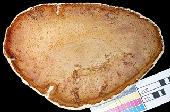 Monocots
Monocots
|
|
What are Monocots? Monocots comprise nearly one fourth of all the living flowering plants, including many economically important ones like rice, corn, wheat, sugar cane, bananas, and bamboo. They get their name from having one cotyledon, or “seed leaf,” which transports nutrients from the seed to the developing embryo. Monocots are most easily recognized by the parallel veins in their leaves. They are primarily tropical plants, although grasses and many others grow in temperate and even polar regions. The fossil record of monocots is patchy and known mainly from pollen, but it extends at least into the Late Cretaceous. First known fossil occurrence: Cretaceous. Last known fossil occurrence: Quaternary. This group has living relatives. Cool Monocots links: Search for images of Monocots on Google |
|


